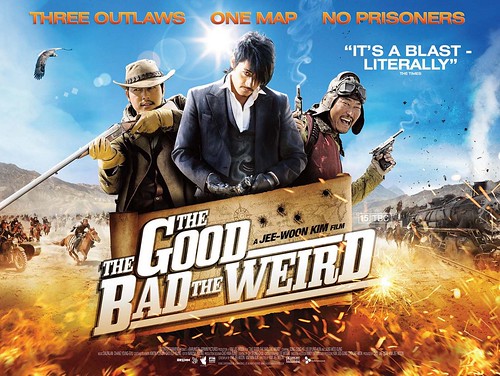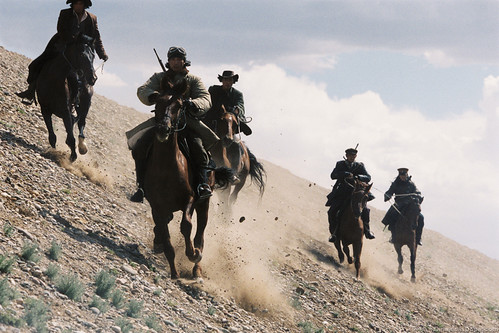PIFF 2010 website

The Good, the Bad, the Weird (South Korea; dir. Kim Ji-woon)
The Good, the Bad, the Weird is a movie that doesn't just go over the top. Each time it climbs a particularly dizzy height, it peers out on the horizon in search of another summit, and then it climbs that, too.
Kim Ji-woon's Sergio Leone homage is being billed as a "kimchi Western." It is in every way Asian cinema's truest response to the 1960s Italian renaissance of the cowboy genre. Set in Manchuria during the 1930s, when China and Korea were occupied by the Japanese, the movie is one long chase, punctuated by occasional gunplay and slaptstick humor. Its trio of anti-heroes are a clean-cut bounty hunter (the good), a killer with anime hair (the bad), and a bumbling train robber (the weird). All cross paths at the start of the picture. The killer, Park Chang-yi (Lee Byung-hun, G.I. Joe: The Rise of Cobra), has been hired to rob a Japanese banker transporting a map believed to lead to the greatest treasure of the Qing dynasty. Only, when he gets on board, he finds that Yoon Tae-goo (Kang Song-ho, The Host
This extended action sequence, which features the three different shooters working independently to stop the train and then coming together in a hail of bullets, is the first in a string of increasingly ludicrous and exhilarating gun battles. As Yoon Tae-goo becomes aware of what he has lifted, he makes a run for the booty, picking up more enemies along the way. By the end of it, not only is he contending with his rivals, including Park Chang-yi's gang, but he's also being chased by colorful bandits and the Japanese army. Horses, jeeps, dynamite, machine guns, mortars--if it can be used to pursue a guy or to try to kill him, expect it to show up. There are even the occasional anachronistic additions just to keep us on our toes. If you are one of those people who worries about where gunfighters get all their ammunition, you'll probably want to see a different movie.
Kim Ji-woon, who also directed A Tale of Two Sisters
The Good, the Bad, the Weird is meant as an admiring wink to all the films that its participants love, and they do a great job of it. The clothes may be more tailored, but the dirt and the heat are just the same as it was in Leone. The film's score openly references Ennio Morricone, and there is even a nod to Quentin Tarantino, borrowing the version of "Don't Let Me Be Misunderstood" he used in Kill Bill
The Good, the Bad, the Weird plays on 2/13, 2/15, and 2/27.

Current Soundtrack: Inglourious Basterds OST


No comments:
Post a Comment